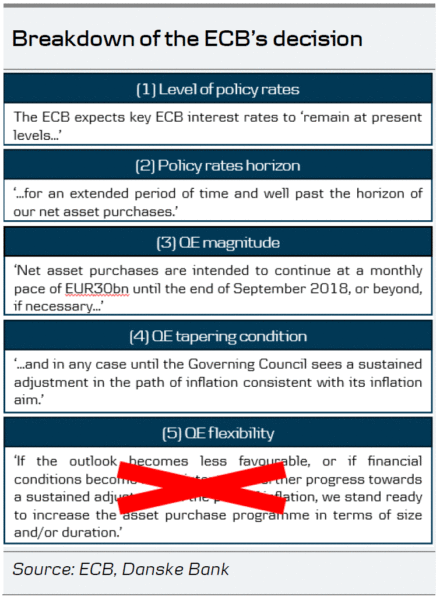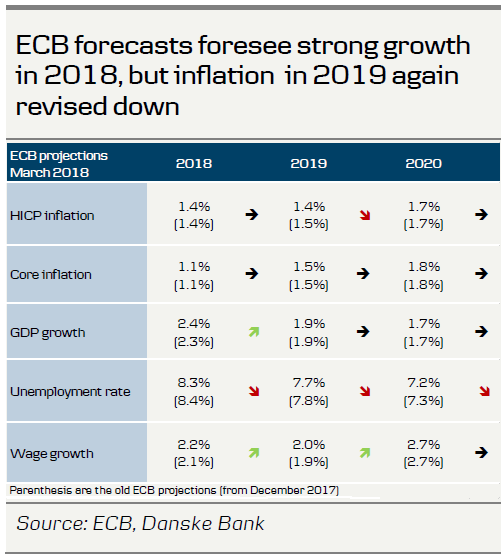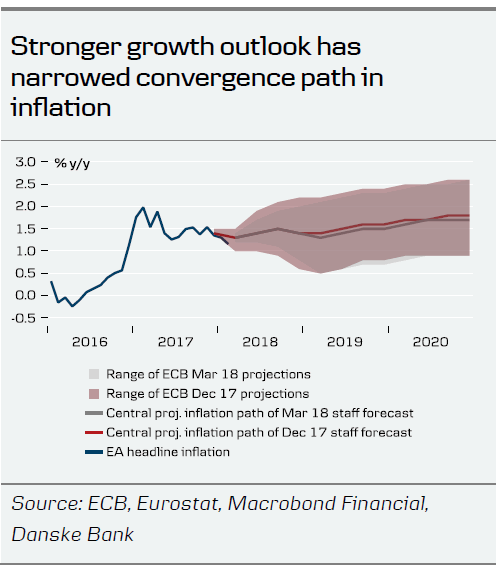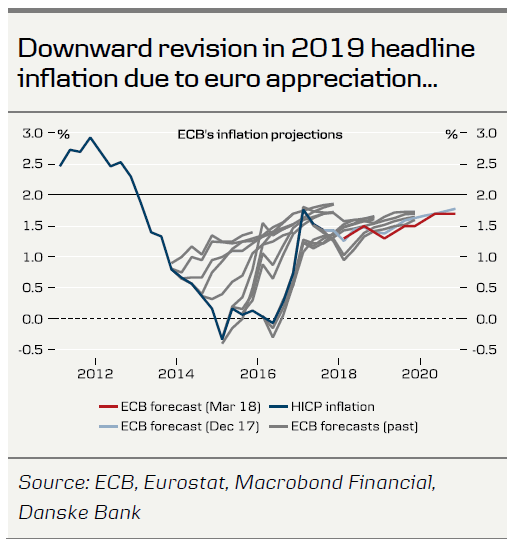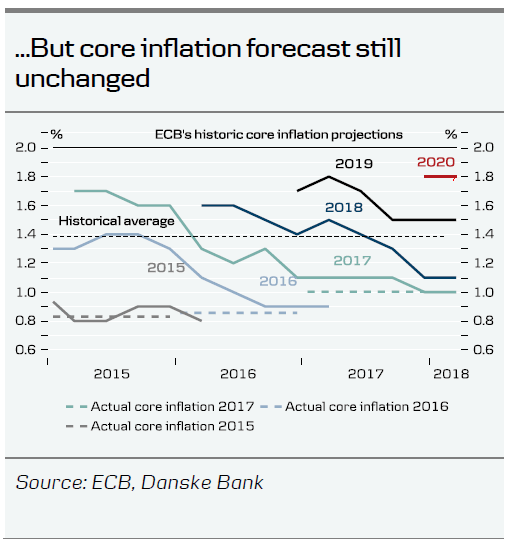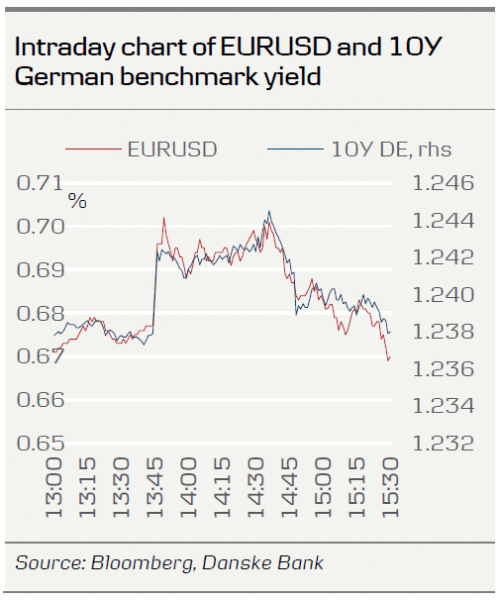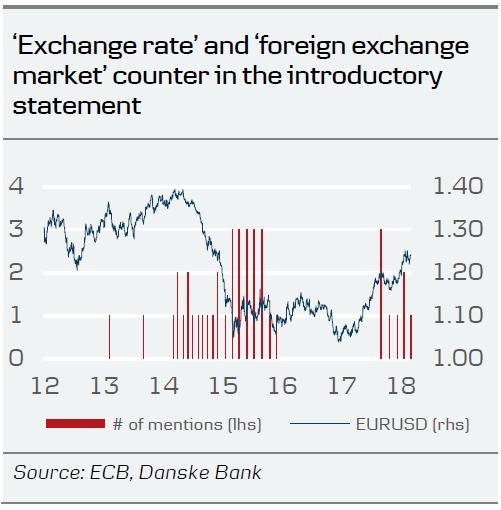- As expected, the ECB’s changed its forward guidance so it no longer entails the QE flexibility. President Mario Draghi struck a softish tone in the press conference, in particular as victory on inflation cannot be declared yet.
- Overall, our ECB view is not changed based on today’s events, as it included little new guidance. Importantly, the decision today was taken unanimously.
- Staff projections. The near-term growth outlook has strengthened but the ECB’s core inflation forecast remains too optimistic.
- Market reaction. The overall implication was a knee-jerk reaction, with the softish language driving yields and the EUR slightly lower, particularly the comment on inflation on declaring victory.
In line with our expectation, the ECB removed their pledge to stand ready to increase the volume if the outlook becomes less favourable. Draghi emphasised the improved economy and the change in language is a natural step to the forward guidance. Recall that this wording has been used since December 2016, when they adjusted the purchase rate from EUR80bn to EUR60bn, at a time when the economic outlook was worse than now (core inflation around 0.8-0.9% and quarterly growth rates around 0.4-0.5% back then).
On inflation we take note of Draghi saying that victory can’t be declared yet on inflation. That’s amongst the most dovish we got today. He also noted uncertainty on output growth and slack in the economy, but we do not view him to be overly concerned on this, for now. The removal of the QE easing bias reflected the stronger growth outlook and thereby also a narrowing of the convergence path in inflation. Further, the lack of bonds available for the QE programme should also be noted. ECB’s Benoît Coeuré presented the free float of eligible German bonds to be less than 10% in a speech on 23 February.
We have previously argued that with deflation risk gone and strong growth fundamentals, ECB could remove the QE bias, but the first rate hike is still not a pressuring theme. We assign the key driver for the first rate hike to be the inflation – and in particular core inflation. We re-emphasise that markets should not be too focused on spot headline inflation but on core (and super-core) inflation. Further, we highlight that the decision today was taken unanimously, which is a very strong signal on the path of communication. Finally, Draghi stepped up its rhetoric on call for other institutions/governments do their job with structural reforms.
ECB core inflation projection remains too optimistic
The ECB also released new economic forecasts at the meeting, which, as expected, were little changed from the December 2017 forecasts.
- Near-term growth outlook has strengthened: The GDP growth forecast for 2018 was lifted marginally to 2.4% from 2.3%, reflecting stronger recent growth momentum and upward revisions in foreign demand, and remains above our forecast of 2.1%. The projection for 2019 and 2020 were left unchanged at 1.9% and 1.7%, respectively. Risks to the growth outlook were judged to be broadly balanced.
- The inflation outlook was slightly revised down, mainly reflecting the dampening effect of the stronger euro. The ECB expects headline inflation to hover around 1.5% for the rest of the year and Draghi stressed that underlying inflation pressures remain subdued and are expected to rise only gradually over the medium-term driven by an expected pick-up in wage growth and continuing economic expansion. The ECB kept its 2018 and 2020 headline inflation forecasts unchanged, but lowered the 2019 forecast by 0.1pp to 1.4%. Surprisingly, core inflation projections remained unchanged despite the expected negative effect of the higher euro exchange rate. The ECB still projects core inflation to accelerate significantly to 1.8% in 2020, supported by an expected strong pick-up in wage growth to 2.7% in 2020, which we still see as optimistic (see also Part 2: Eurozone Inflation – Upside risks from oil prices and rising wage pressures), 27 February.
Fixed income
The overall implications on the fixed income markets from the ECB meeting and the press conference is modestly upward pressure on the core EU rates combined with a bearish flattener between 5Y and 30Y on the German government curve and the EU swap curve.
The periphery continue to perform despite the rise in rates. The ECB is able to signal a gradual approach to “scaling down” QE without hurting the peripheral markets. Hence, we have hit our profit target on being long 10Y Portugal relative to swaps. Our long position in 10Y Spain has also performed well.
FX
EUR/USD moved towards 1.2450 on the announcement of QE flexibility being removed, and also initially pressed higher still as Draghi did not come out as soft as expected at first. However, with Draghi framing the change in language as a natural step given the ‘strong’ outlook – and thus the move not representing that the ECB is in a hurry to ‘exit’ as such – the EUR/USD rally faded somewhat. Thus the year-to-date high of 1.2555 was not at risk today.
Despite some brief comments on the challenges arising from a stronger currency, we think that today’s shift in forward guidance, while not in itself a trigger for a new EUR uptrend, will keep alive FX markets’ belief in the ECB keeping up the pace in its the gradual move towards the ‘exit’. The potential for this to support the single currency, not only from a relative rates point of view, but also from a capital-flow point of view still holds EUR upside.
Further, with omnipresent arguments for USD weakness, see Part 5: FX and inflation – US inflation outperformance + comfy Fed = weaker USD, 2 March, it leaves EUR/USD fundamentally supported. In our view, this leaves the 1.21-1.26 range for the pair intact for now, but the cross is set to continue to grind higher further out. A possible trigger for this could be the ECB looking to adjust its rates communication which we do not expect to happen before the September 2018, at the earliest.




